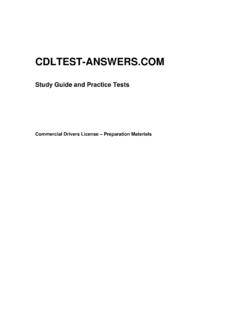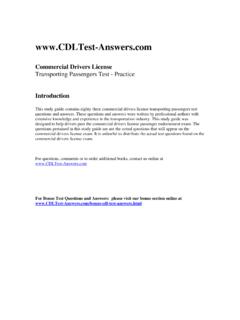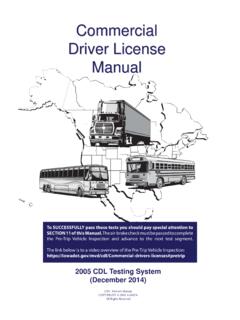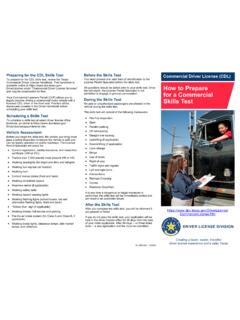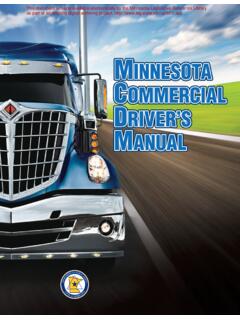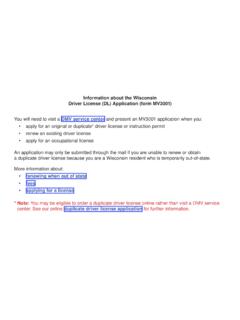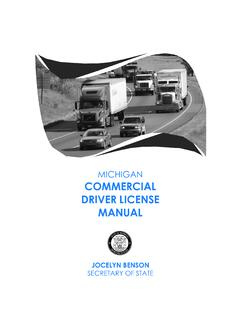Transcription of General Knowledge CDL - CDL PRACTICE TEST
1 drivers LicenseGeneral Knowledge Test-PracticeIntroductionThis study guide contains one hundred ninety one commercial drivers license General Knowledge testquestions and answers. These questions and answers were written by professional authors with extensiveknowledge and experience in the transportation industry. This study guide was designed to help driverspass the commercial drivers license General Knowledge exam. The questions pertained in this study guideare not the actual questions that will appear on the commercial drivers license exam. It is unlawful todistribute the actual test questions found on the commercial drivers license questions, comments or to order additional books, contact us online Bonus Test Questions and Answers: please visit our bonus section online Knowledge PRACTICE Test Questions1) What is the most important reason for doing a vehicle inspection?A. State law requires vehicle inspectionsB.
2 Safety is the most important reason to inspect your vehicleC. To make sure your lights are working properlyD. To check for over inflatedtires2) What things should you check during a trip?A. Watch for pedestrians crossingB. Check brake fluid levelC. Watch gauges for signs of troubleD. Make sure your signals are working properly3) Name some key steering Tires, rims, lug nutsB. Leaf springs, bellows, eye boltC. Axle, control arm, pressure plateD. Spindle, tie rod, drag link4) Name a suspension system Leaking shock absorbersB. Under inflated tiresC. Loose lug nutsD. Cracked brake cylinder5) What 3 kinds of emergency equipment should you have?A. Flash light, tire gauge, tire inflation foamB. First aid kit, bandage gauze, pain relieverC. Fire extinguisher, spare electrical fuses, warning deviceD. Exterior hazard light,cell phone, wheel chock6) What is the minimum tread depth for front tires? inchB. 2/32 inchC. 7/16 inchD.
3 3/8 inch7) What is the minimum tread depth for other tires? inchB. 2/32 inchC. 7/16 inchD. 3/8 inch8) Name some things you should check on the front of your vehicle during the walk aroundinspection?A. Fuel tank, engine, tiresB. Brakes, air lines, suspensionC. Signal and clearance lights, headlightsD. Cab area, coupling system, rims9) What should wheel bearing seals be checked for?A. TightnessB. LeakingC. Fluid levelD. Safety10) How many reflective triangles should you carry?A. 2B. 4C. 1D. 311) Why should you back toward the driver s side?A. State law requires backing toward the driver s sideB. Because it takes less timeC. Because you can see betterD. So you won t have to look over your passenger12) What is a pull-up?A. Re-positioning of your vehicle when backingB. A replacement for backingC. Short forward movement to save brake wearD. A Diaper13) If stopped on a hill, how can you start moving without rolling back?A. Place wheel chock under front wheelB.
4 Place wheel chock under rear wheelC. Partly engage clutch before taking yourfoot off the brakeD. Use your parking brake14) When backing, why is it important to use a helper?A. To help avoid blind spotsB. To watch for obstaclesC. To free the passenger side mirrorD. So you will not have to do all of the work15) What's the most important hand signal that you and the helper should agree on?A. Pull upB. Back upC. GoD. Stop16) What are the 2 special conditions where you should downshift?A. Before stopping and exiting a starting off and driving uphillC. Before shutting engine off and before exiting vehicleD. Before starting down a hill and before entering a curve17) When should you downshift automatic transmissions?A. Before starting downgradeB. Before starting upgradeC. Before entering curveD. Before exiting curve18) Retarders keep you from skidding when the road is slippery. True or False?A. TrueB. False19) What are the 2 ways to know when to shift?
5 A. Engine sound, engine speed, road speedC. Eight seconds after leaving previous gear, clutch loosensD. Clutch tightens, rpms drop20) How far ahead should you look when driving?A. 10 to 12 secondsB. 8-10 secondsC. 12 to 15 secondsD. 15-17 seconds21) What are the 2 main things to look for ahead?A. Traffic and road conditionsB. Vehicles and stoplightsC. Disabled vehicles and obstaclesD. Curves and potholes22) What's your most important way to see the sides and rear?A. Use your helperB. Use your mirrorsC. Use your signalsD. Use your horn23) What does "communicating" mean in safe driving?A. Using cell phonesB. Braking oftenC. Using your hornD. Signaling your intentions24) Where should your reflectors be placed when stopped on a divided highway?A. 50 /50 /50 B. 100 /50 /50 C. 10 /100 /100 D. 100 /100 /10 25) What 3 things add up to total stopping distance?A. Stopping distance/ reaction distance/ perception distanceB. Vehicle distance/ stopping distance/ reaction distanceC.
6 Braking distance/ obstacle distance/ stopping distanceD. Perception distance/ reaction distance/ braking distance26) If you go twice as fast, your stopping distance will increase by twice or 4 times?A. TwiceB. Four times27) Empty trucks have the best braking. True or False?A. TrueB. False28) What is "hydroplaning"?A. Tires lose contact with road and have no tractionB. Turning steering wheel but vehicle doesn t turnC. Braking but vehicle doesn t stopD. Formof surfing29) What is "black ice"?A. Very hot slippery tarB. Oil slick on the roadwayC. Snow on the roadwayD. Thin sheet of clear ice on roadway30) You should use low beams whenever you can. True or False?A. TrueB. False31) What should you do before you drive if you are drowsy?A. EatB. SleepC. Drink coffeeD. Exercise32) What effects can wet brakes cause?A. Slower stopping speedB. HydroplaningC. brake wearD. Lack of braking power33) You should let airout of hot tires so the pressure goes back to normal.
7 True or False?A. TrueB. False34) You can safely remove the radiator cap as long as the engine isn't overheated. True or False?A. TrueB. False35) What factors determine your selection of a"safe" speed when going down a long, steepdowngrade?A. Speed/ space/ distance / perceptionB. Reaction time/ distance/ speed/ vehicle sizeC. Weight of vehicle/ length of grade/ steepness/ road conditions/ weatherD. Perception/ reaction/ speed of vehicle/ stopping distance36) Why should you be in proper gear before starting down a hill?A. So you can focus on brakingB. You may not be able to shift back into any gear and all braking effect will be lostC. To maintain speedD. So you will not damage the transmission37) Describe the proper braking technique when going down a long, steep ) What is a "hazard"?A. Any road condition or user that is a possible dangerB. Any obstacle in the roadwayC. Anything that obstructs the roadwayD. A game of chance39) Why make emergency plans when you see a hazard?
8 A. So you won t hurt your vehicle or anyone elseB. So you will have more time to actC. So you won t have to make plans afterwardD. To avoid hittingsomething40) Stopping is not always the safest thing to do in an emergency. True or False?A. TrueB. False41) What is an advantage of going right instead of left around an obstacle?A. You will avoid skiddingB. You will avoid hydroplaningC. You will avoid drivers passing on the leftD. You will avoid a head on collision42) What is an "escape ramp"?A. A highway exit in case you can t change lanesB. Any highway exitC. An extra lane to pass slower trafficD. An exit at the bottom of a hill to slow you down and stop43) If a tire blows out, you should put the brakes on hard to stop quickly. True or False?A. TrueB. False44) What is one thing to do at an accident scene to prevent another accident? your vehicle immediately no matter which lane you are inB. Stand in the middle of the lane and wave to oncoming trafficC.
9 Call your bossD. Put out flares45) Name 2 causes of tire fires?A. Speed and excessive brakingB. Over inflated tiresand turning sharplyC. Weight of vehicle and road conditionsD. Under inflated tires and duals that touch46) What kind of fire is a B:C extinguisher good for?A. Electrical, fuelB. Meat, cheeseC. Wood, paper, clothD. Metal, rubber47) When using your extinguisher, should you get as close as possible to the fire?A. YesB. No48) Name a cause of vehicle Flammable cargoB. Sudden stoppingC. OverheatingD. Excessive road temperature49) For what 3 things related tocargo are drivers responsible?A. Size of cargo, where cargo is placed, and unbalanced cargoB. Inspection of cargo, balanced weight of cargo, secured cargo50) How often while on the road must you stop to inspect your cargo?A. Every 3 hours or 150 milesB. Every 6 hours or 300 milesC. Before and after your trip51) What is the "gross combination weight" (GVW)?A. Weight of cargo, plus weight of drivers and passengersB.
10 The maximum weight specified by the manufacturer that a vehicle can holdC. Weight of trailer plus weight of cargoD. Weight of power unit, plus trailer, plus cargo52) Name a situation where legal maximum weight may not be Mountain travelingB. Crossing bridgesC. OverloadingD. Transporting hazardous materials53) What can happen if you don't have enough weight on the front axle?A. Your front end will hydroplaneB. Can cause poor tractionC. Will cause "fishtailing"D. Will damage shock absorbers54) What is the minimum number of tie downs for a 20 foot load?A. At least one tie down for every 20 feetB. At least two tie downs for every 10 feetC. At least one tie down for every 5 feetD. At least one tie down for every 10 feet55) What is the minimum number of tie downs for any flatbed load?A. 1B. 2C. 3D. 456) Name 1 basic reason for covering cargo on an open Protect cargo from theftB. Insurance requirementsC. Protect the cargo from weatherD.

